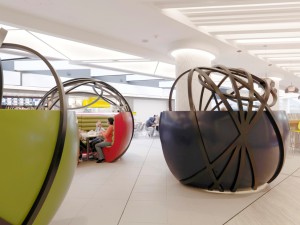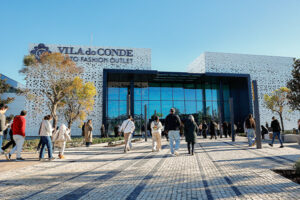BY JONATHAN DOUGHTY
We are all aware of why foodservice is so important to shopping centers in that it clearly increases dwell time, provides a point of difference, and gives the consumer a regular reason to visit, especially if they are located in an office building nearby. In the old days, food could simply be distributed around the center and it either worked or didn’t work. But we are now seeing a very strong trend, guided by Coverpoint in many cases, to create “Dining Destinations.” These are not high class or expensive locations but simply a concentration of foodservice in one area creating an attractive choice and variety for the consumer. We know that the guest likes to go to these locations or “Dining Destinations” because they provide choice and variety in one place, allowing the customer to choose when they arrive. Whether that choice is about cuisine, service style, or price point, guests are able to make their decisions when they want to if they are presented with a cluster of operations.
It is also important to recognize that we are not just talking about food courts; while many new food courts have been created in the past five years around Europe, they only suit certain locations and require extremely careful planning and execution to make them successful. “Dining Destinations” do not have to be based around common seating areas, but can instead be a collection of cafés and restaurants with their own seating areas and individual brand “look and feel.”
There are always some sensible rules that need to be followed when creating “Dining Destinations,” so I thought it would be useful to set these out for discussion and debate and to provide some guidance on developing food and beverage in the future:
UNDERSTAND THE MARKET
It sounds basic, but so many projects start without a real understanding of the consumer base and the potential. We need to know if there is a significant office population nearby, a transit location, or education establishments, as all of these will provide additional, but very time specific, consumers each day.
SIZE IS IMPORTANT
The design layout and size of any “Dining Destination” needs to be able to accommodate consumers when they come to that location for their food needs. Too many are small and have inadequate numbers of seats with too many operators, as the rent roll is considered the most important thing. At Coverpoint, we know that seats equal turnover and having insufficient seating can significantly damage the success of a “Dining Destination.”
DAYPART
We have recently been involved in a project where, after construction, we were asked why the “Dining Destination” was not achieving the expected level of sales. At peak times it was, but out of lunch and early dinner times, very little business was being achieved. One look at the type of operators and it was clear that none of them offered a strong breakfast, mid-morning, mid-afternoon, or snack and beverage offer. Limiting the product offer to main meals only produced higher theoretical rent, but the daypart mix was just wrong.
SALES PER MINUTE
Coverpoint spends a lot of time looking at how productive foodservice operators are from the perspective of each of their customers, or guests as we like to call them. There are some significant differences in the amount of money that an operator can take from a guest for every minute that each guest spends in the location. Not un-surprisingly, fast casual operators achieve a high average transaction of €8 to €9 in less than 15 minutes. This is one of the reasons why it is such a successful and growing sector of the foodservice industry.
DINNER AND LEISURE
If you are lucky enough to have a cinema in your center, you have the opportunity to provide your guests with their third meal occasion of the day. The evening meal, if taken before or after a cinema visit, represents a significantly higher average spend than breakfast or lunch. However, to achieve this, we strongly recommend that the restaurant locations are clustered near the entrance to the cinema. In this way, guests can stay at their tables longer knowing they only have a short trip to their cinema seat. It is our view that “Dining Destinations” trade better than distributed foodservice and we would consider turnover to be at least 15% higher per square meter in “Dining Destinations” if they are properly designed and launched. We believe operators trading together in one space create a more appealing and enjoyable location than individual offers spread out on retail malls. This is especially true in centers that have an evening leisure economy wherein the shops don’t stay open late.

“Dining Destination” at intu’s Lakeside shopping center in Essex. IMAGE: COVERPOINT FOODSERVICE CONSULTANTS
“Dining Destinations” therefore need to have broad, all-day appeal. This should include a range of food types, cuisines, service styles, and, ideally, a range of price points. The type of user also needs to be considered, and if it is going to be truly successful, it is important to create different areas for different consumers. This might mean business zones for office workers with power sockets and WiFi, or areas with soft play facilities and bottle warming for guests with young children.
For all guest types, it is important to create destinations that people want to spend time in, spaces that do not look and feel like retail malls, with attractive design and a vibrant atmosphere that will pull people into the spaces throughout the trading day. We know that guests like “Dining Destinations” as there is plenty of choice and variety to ensure that we satisfy their needs, but careful planning is key in ensuring destinations are attractive for both guests and operators.
What is your opinion on this topic? Discuss it with us! Send your opinion to opinion@across-magazine.com !






